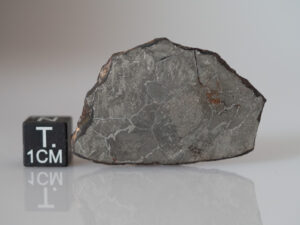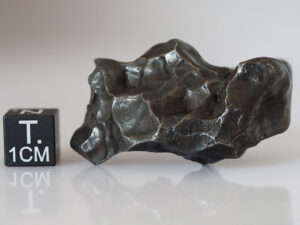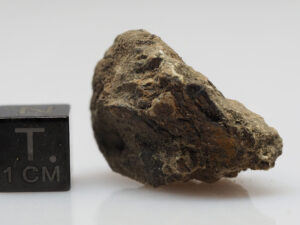Description
Iron, IIG.
Slice – 3.8g. Sold with label/certificate of authenticity.
*** If you buy from the € zone, please use € on my website and for payment. You’ll avoid paying Paypal conversion fees ! ***
DISCOVERY OF THE TWANNBERG, SWITZERLAND, IRON METEORITE
Name: TWANNBERG
Place of find: Nidau district, canton Bern, Switzerland.
47°7’28″N.,7°10’44″E.
Date of find: 9 May, 1984
Class and type: Iron. Hexahedrite to coarsest octahedrite. 5.1% Ni. Similar in structure and composition to Tombigbee River.
Number of individual specimens: 1
Total weight: 15.91 kg
Circumstances of find: Found in a barley field, after ploughing.
Source: R.W Buehler, P.O. Box 6, CH-5026, Densbueren, Switzerland; V.F. Buchwald, Institute of Metallurgy, Bygning 204, 2800 Lyngby, Denmark.
[From MetBull 91]
Twannberg 47°05.73′N, 7°09.45′E
Twannberg, Canton of Berne, Switzerland
Find: 1984
Iron (IIG)
History: Two additional masses of Twannberg were recovered in 2000 and 2005, in both cases in non-natural settings indicating earlier collection. Mass II (2246 g) was found in August 2000 in the attic of an old house (Dorfgasse 7) in the village of Twann by Marc Jost. Mass III (2533 g) was identified in September 2005 in a rock and mineral collection deposited at NMBE as a permanent loan from the Museum Schwab, Biel, Switzerland, where the sample was originally labelled as “hematite,” probably around 1932. Both secondary find places are in the vicinity (3.5 and 5 km distance) of the original find locality.
Physical characteristics: (B. Hofmann, NMBE) Both newly recovered masses are of irregular elongated shape, and are covered by an oxide rind several millimeters thick, with abundant incorporated terrestrial silicate sand grains corresponding to local glacial till deposits of the Rhône Glacier. Similar sand grains were also observed in the oxide rind of the first mass.
Petrography: Both new masses show a texture identical to the first mass. Large schreibersite crystals (up to 4 cm in length) are enclosed in kamacite. Fracturing follows thin (10– 20 µm) plates of rhabdite present in up to 10 different orientations.
Mineral compositions and geochemistry: (J. Wasson, UCLA) Analysis of mass II (INAA data) yielded values very similar to those reported for the first mass: Ni = 46.7, Co = 5.17 (both mg/g); Ga = 37.3, As 18.0, Ir 0.101, Pt 1.0, Au 1.406 (all g/g).
Classification: Iron (IIG). Pairing of the two new masses with Twannberg is supported by identical mineralogy and texture, oxide rind petrography including nonmeteoritic silicate grains and bulk chemistry.
Type specimen: The majority of the original mass (10,536 of 15,915 g) and both newly recovered masses are located at NMBE. The total known mass of Twannberg now is 20,694 g.



